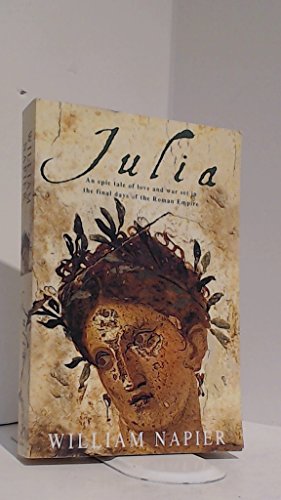Items related to Julia: An Epic Tale of Love and War Set in the Final...

"synopsis" may belong to another edition of this title.
colourful, full of action and adventure' 21/10 The Independent on Sunday (The Independent on Sunday)
I remember first reading about her in the newspapers, back in the spring of 1999, and being tantalized by the few available facts. She died in London, around 350 AD, or so they reckoned. But she spent her childhood in Italy or Spain. She died in her early twenties, without having had children, and most probably unmarried. She had a lavish, and pagan burial, at a time when the Roman Empire was officially Christian, and increasingly intolerant of non-Christians. She did not die a violent death, but most probably of an
infectious disease. She was rich, cultured, dark-haired and dark-eyed, petite, around 5’4. And this was about all they knew of her. They didn’t even know her name. But in my mind, I had already decided it was ‘Julia.’ I have always had a fascination for the Ancient World, and now here was a glimpse of it, right on my doorstep. My novelist’s imagination was fired. Why did she come to London? Was she running away from something? And what must it have been like, to make that long, perilous sea crossing as a child? And then what happened in London? How must life have been for a wealthy pagan woman and her family, in an officially Christian Empire? As I started wondering, I begun to read around the subject in the history books, and became more and more intrigued. The period during which she had died was a dark and turbulent one. In Britain, the wild tribesmen of the North, the Picts, were making more and more frequent incursions over the great Wall built by Hadrian. The first Saxon raiders were attacking the east coast. Across the Empire there was rampant inflation, civil unrest, sporadic civil war. Rome’s mighty frontiers were crumbling, and her oldest and greatest enemy, Persia, was massing on her eastern borders. And in London, at exactly this period, there was the most extraordinary period of brutal repression, interrogation, torture and other horrors, under the command of a sinister Imperial officer called Paulus Catena: Paulus ‘The Chain.’ And most of his victims were wealthy, and pagan . . . So this is how the story began in my mind. How it ended . . . but that would be telling. I hope you enjoy finding out for yourself. William Napier
"About this title" may belong to another edition of this title.
- PublisherHeadline Review
- Publication date2002
- ISBN 10 0747231354
- ISBN 13 9780747231356
- BindingPaperback
- Number of pages320
- Rating
Buy New
Learn more about this copy
Shipping:
£ 3.36
Within U.S.A.
Top Search Results from the AbeBooks Marketplace
Julia
Book Description Soft cover. Condition: New. No Jacket. A novel of Ancient Roman. Seller Inventory # 000806

